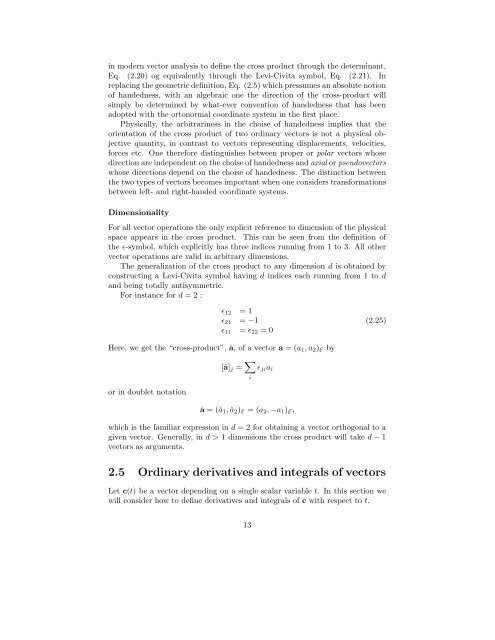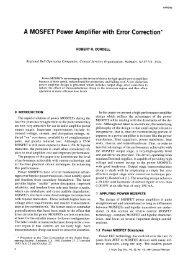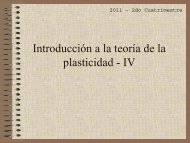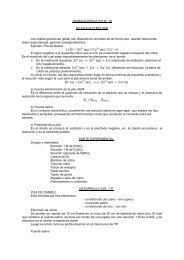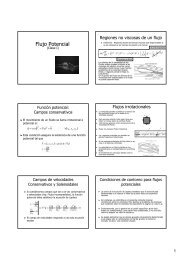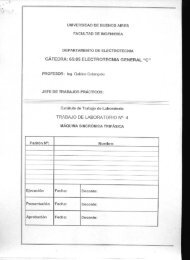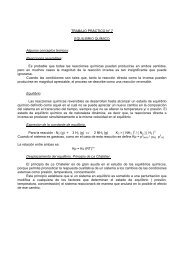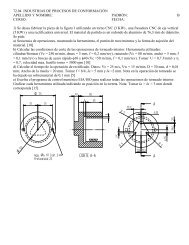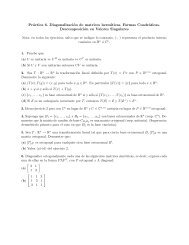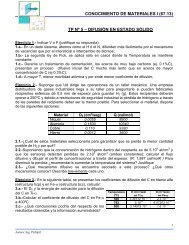Introduction to vector and tensor analysis
Introduction to vector and tensor analysis
Introduction to vector and tensor analysis
You also want an ePaper? Increase the reach of your titles
YUMPU automatically turns print PDFs into web optimized ePapers that Google loves.
in modern vec<strong>to</strong>r <strong>analysis</strong> <strong>to</strong> define the cross product through the determinant,<br />
Eq. (2.20) og equivalently through the Levi-Civita symbol, Eq. (2.21). In<br />
replacing the geometric definition, Eq. (2.5) which pressumes an absolute notion<br />
of h<strong>and</strong>edness, with an algebraic one the direction of the cross-product will<br />
simply be determined by what-ever convention of h<strong>and</strong>edness that has been<br />
adopted with the or<strong>to</strong>normal coordinate system in the first place.<br />
Physically, the arbitrariness in the choise of h<strong>and</strong>edness implies that the<br />
orientation of the cross product of two ordinary vec<strong>to</strong>rs is not a physical objective<br />
quantity, in contrast <strong>to</strong> vec<strong>to</strong>rs representing displacements, velocities,<br />
forces etc. One therefore distinguishes between proper or polar vec<strong>to</strong>rs whose<br />
direction are independent on the choise of h<strong>and</strong>edness <strong>and</strong> axial or pseudovec<strong>to</strong>rs<br />
whose directions depend on the choise of h<strong>and</strong>edness. The distinction between<br />
the two types of vec<strong>to</strong>rs becomes important when one considers transformations<br />
between left- <strong>and</strong> right-h<strong>and</strong>ed coordinate systems.<br />
Dimensionality<br />
For all vec<strong>to</strong>r operations the only explicit reference <strong>to</strong> dimension of the physical<br />
space appears in the cross product. This can be seen from the definition of<br />
the ɛ-symbol, which explicitly has three indices running from 1 <strong>to</strong> 3. All other<br />
vec<strong>to</strong>r operations are valid in arbitrary dimensions.<br />
The generalization of the cross product <strong>to</strong> any dimension d is obtained by<br />
constructing a Levi-Civita symbol having d indices each running from 1 <strong>to</strong> d<br />
<strong>and</strong> being <strong>to</strong>tally antisymmetric.<br />
For instance for d = 2 :<br />
ɛ12 = 1<br />
ɛ21 = −1<br />
ɛ11 = ɛ22 = 0<br />
Here, we get the “cross-product”, â, of a vec<strong>to</strong>r a = (a1, a2)E by<br />
or in doublet notation<br />
[â]j = <br />
i<br />
ɛjiai<br />
â = (â1, â2)E = (a2, −a1)E,<br />
(2.25)<br />
which is the familiar expression in d = 2 for obtaining a vec<strong>to</strong>r orthogonal <strong>to</strong> a<br />
given vec<strong>to</strong>r. Generally, in d > 1 dimensions the cross product will take d − 1<br />
vec<strong>to</strong>rs as arguments.<br />
2.5 Ordinary derivatives <strong>and</strong> integrals of vec<strong>to</strong>rs<br />
Let c(t) be a vec<strong>to</strong>r depending on a single scalar variable t. In this section we<br />
will consider how <strong>to</strong> define derivatives <strong>and</strong> integrals of c with respect <strong>to</strong> t.<br />
13


